Kate Rauner's Blog, page 69
September 3, 2016
Mysterious Ways – flash fiction is live :) #scifi #fantasy #podcast ;)

Strange women walking on mars?
Here’s a reminder – starting now listen to my short short-story about an angel visiting Mars.
Mysterious Ways is now a podcast starting at 6pm CST.
It’s exciting for me to hear one of my stories read aloud, and it’s perfect for your trip to work or a break during the day. Try some of the other stories at 600 Second Saga, too.
Choose your favorite way to listen:
iTunes
Stitcher
YouTube
600 Second Saga podcast feed
Or just go to 600 Second Saga
New to podcasts? How to listen to podcasts
Thanks to Mariah Avix at 600 Second Saga: Tales of Science Fiction and Fantasy. The 600 Second Saga team appreciates sharing, reviewing, and rating the podcast – this helps to reach more people. Please consider giving us a rating in iTunes.
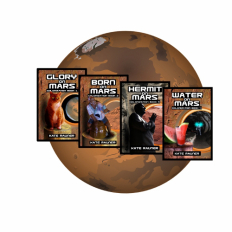 Read one of my books today at Amazon, Barnes & Noble, iTunes, Kobo, and other major on-line retailers. Books 1 and 2 of the On Mars series are available with books 3 and 4 coming in fall 2016. Catch up now.
Read one of my books today at Amazon, Barnes & Noble, iTunes, Kobo, and other major on-line retailers. Books 1 and 2 of the On Mars series are available with books 3 and 4 coming in fall 2016. Catch up now.
Receive any of my books free – click here to find out how.
Filed under: Kate's Books, Science Fiction








August 31, 2016
Mysterious Ways – flash fiction #scifi #fantasy #podcast goes live on Friday Sept 2nd

From NASA’a Curiosity – but is it just a rock? a digital artifact?
Listen to Mysterious Ways on the Sept 2nd podcast of 600 Second Saga starting at 6pm CST.
I’m happy to say my short short-story about an angel visiting Mars will be podcast next week. It’s exciting for me to hear one of my stories read aloud, and it’s perfect for your trip to work or a break during the day. Listen in and try some of the other stories, too.
Thanks to Mariah Avix at 600 Second Saga: Tales of Science Fiction and Fantasy. Choose your favorite way to listen:
600 Second Saga podcast feed
Or go to 600 Second Saga
Or iTunes, Stitcher, or YouTube starting Friday
New to 600 Second Saga? How to listen to podcasts
The 600 Second Saga team appreciates sharing, reviewing, and rating the podcast – this helps to reach more people. Please consider giving us a rating in iTunes.
Mariah is now accepting flash fiction submissions for future podcasts – let your favorite author know or (authors!) submit one of your own pieces.
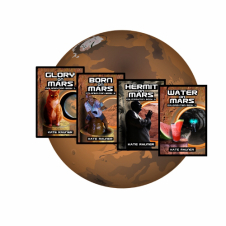 Read one of my books today at Amazon, Barnes & Noble, iTunes, Kobo, and other major on-line retailers. Books 1 and 2 of the On Mars series are available with books 3 and 4 coming in fall 2016. Catch up now.
Read one of my books today at Amazon, Barnes & Noble, iTunes, Kobo, and other major on-line retailers. Books 1 and 2 of the On Mars series are available with books 3 and 4 coming in fall 2016. Catch up now.
Receive any of my books free – click here to find out how.
Filed under: Kate's Books, Science Fiction Tagged: Fantasy, flash fiction, mars, NASA rover Curiosity, pareidolidal images, Sci Fi, science fiction, SciFi, sf, short story








August 27, 2016
Closest Star Has Planet With Earthiness #star #space #tech #science
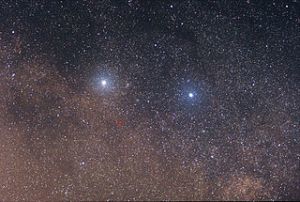
The two bright stars are (left) α Centauri and (right) β Centauri. The faint red star in the center of the red circle is Proxima Centauri. – the planet has been detected using spectrographs
The closest star to Earth’s Sun, called Proxima Centauri, is a relatively faint and cool red dwarf. It doesn’t seem a promising place to look for a second home for humanity – but, surprise!
It seems to have a rocky planet a bit bigger than Earth, with a “year” that’s 11.2 days long. It’s a lot closer to its star than Earth to the Sun, but because the star is cool, it gets about 2/3 the light and heat Earth does. It could have liquid water.
This is HUGE news: Astronomers have found a planet orbiting the Proxima Centauri, the closest star to the Sun! Holy wow. Seriously. Wow.” [Bad Astronomy]
If it has an atmosphere and if that atmosphere has CO2 and if that atmosphere isn’t toxic – it might possibly support earth-like life. But not life with technology like ours – SETI has listened to Proxima and heard nothing exciting.
Close is relative in the galaxy – Proxima is 40 trillion kilometers away. That’s about 4 light years and we have no way to travel at near-light speed. But maybe we can get close enough for a mission to fit within a human lifetime.
Aided by famed physicist Steven Hawking, billionaire Yuri Milner is prepared to send probes – teeny-tiny probes.
Instead of sending one big expensive machine, you can send hundreds of these. Interstellar medium is dangerous. There are dust particles that can destroy your technology… a grain of dust, only a hundredth of a millimeter big, could completely destroy [a single probe]. At the rate and distance it’d be traveling, 30 percent of the craft would be eaten away by dust before it got there.” [Popular Science]
Propelled by a tiny light sail receiving a laser beam from Earth (or from Earth orbit) each probe could build up to a decent 20% of light speed.
Of course, there’s nothing at Proxima to slow the probes down, so this would be a
Flyby mission. You go for 20 years, and you have about 1 day to take your measurements [and] a few years to send the images back.” [Popular Science]
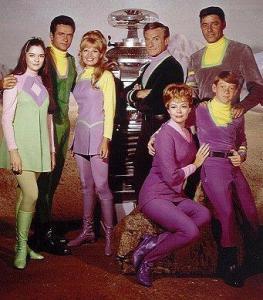
Promo for Lost in Space, scifi/fantasy TV show that sent settlers to Proxima Centauri’s partner star Alpha Centauri – see fair use via link
While we wait for this billionaire’s hobby-probes to take flight, I’m hopeful telescopes will eventually see if there’s a faint fuzziness to the planet which could indicate an atmosphere. That would encourage exploration. Maybe some future teeny-tiny probes could be big enough to carry breaking engines and enter orbit. There’s no reason to wait for the first probes to arrive before launching a second and third generation – if the billionaire’s money holds out.
I may never see such probes fly – but like Bad Astronomy says: Wow.
Thanks Bad_Astronomy and Popular Science.
Filed under: Neat Science News Tagged: atmosphere, Bad Astronomy, earthlike planet, exoplanet, is there life in the galaxy universe, laser, probe, Proxima Centauri b







August 24, 2016
Earth Fifty Million Years Ago #geology #science #earthquake #poem #poetry #nature

Tectonic plate movement today
Earth’s history runs deep,
‘Neath hundreds of miles where
Seismic waves flow through the rock
Like light waves through the air.
Ancient surface plates
That sunk beneath the crust
Last saw the sun when dinosaurs
Lay dead in ash and dust.
Subducted shallow seas
Converged and disappeared,
That’s what captured earthquake waves
Now show
From fifty million years
Ago.
By Kate Rauner
Thanks to livescience.com and National Taiwan University geologists for their study of the deep Earth’s East Asian Sea Plate at the Philippine Sea.
 All my books, including collections of my science-inspired poetry, are available at Amazon, Barnes & Noble, iTunes, Kobo, and other major online retailers. You’ll also find paperbacks at Create Space and all major digital formats at Smashwords. Read one today.
All my books, including collections of my science-inspired poetry, are available at Amazon, Barnes & Noble, iTunes, Kobo, and other major online retailers. You’ll also find paperbacks at Create Space and all major digital formats at Smashwords. Read one today.
Filed under: Poetry Tagged: Earth's crust, earthquake waves, geology, paleoseismology, plate tectonics, poem, poetry, science, seismic waves








August 20, 2016
Boots on Mars! Soon, But Soon Enough? #Mars #explore #science #NASA #tech
 The next twenty years promise excitement for Mars lovers. Will Mars One get beyond selling tee-shirts and running bench experiments? Will the Mars Society continue their simulation missions in the Utah Desert and the Canadian Arctic? Will SpaceX send a rocket that can land like Buck Rogers on the Red Planet a mere three years from now? Etcetera, because these aren’t the only organizations with an eye on Mars.
The next twenty years promise excitement for Mars lovers. Will Mars One get beyond selling tee-shirts and running bench experiments? Will the Mars Society continue their simulation missions in the Utah Desert and the Canadian Arctic? Will SpaceX send a rocket that can land like Buck Rogers on the Red Planet a mere three years from now? Etcetera, because these aren’t the only organizations with an eye on Mars.
Several governments are sending robotic craft to Mars, but NASA has a long history. Non-profits, private companies, and countries new to space may seem like long-shots, though they sure sound serious.
So what about NASA?
NASA and Lockheed Martin, together with several international partners and private industries, would like to conduct a comprehensive exploration to the hostile planet… Mars Base Camp [will be a] massive central space station made up of two Orions with two science laboratories.”
By 2028, an international crew will orbit Mars in an environment we have a lot of experience with – a space station – controlling remote rovers in real-time on the planet and its two moons. Scientists will be trained to become astronauts, rather than the other way around so, like most of the organizations I mentioned above, the military flavor will be gone.
NASA’s pioneers will return home to Earth and new crews will replace them. Eventually, once we’re convinced there’s no Martian life we could damage, people will set foot on the planet. If we still want to by then, I suppose. Our vision of life on Mars will be clearer by then and, even with advanced technology, it will be a hard life.
NASA won’t land soon enough for many private groups that want to colonize the planet today. There are crews in today training who expect to live and die on Mars.
How I wish I could see a hundred years into the future.
Can’t wait? All my books, including the On Mars series, are available at Amazon, Barnes & Noble, iTunes, Kobo, 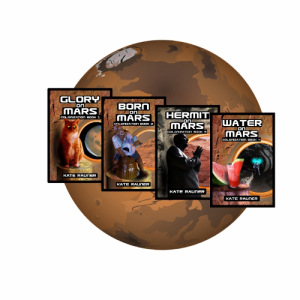 and other major online retailers, including Smashwords for all digital formats and Create Space for paperbacks. On Mars books 1 and 2 are available now, with books 3 and 4 due out this fall. Read one today.
and other major online retailers, including Smashwords for all digital formats and Create Space for paperbacks. On Mars books 1 and 2 are available now, with books 3 and 4 due out this fall. Read one today.
Check out:
http://www.nasa.gov/content/nasas-journey-to-mars
Thanks to scienceworldreport.com for the quote above.
Filed under: Neat Science News Tagged: colonize, colony, Lockheed Martin, mars, Mars One, Mars Society, NASA, Red Planet, science fiction on Mars, SpaceX, when will humans land on Mars








August 17, 2016
Universe’s Missing Piece #physics #science #poetry #boson #poem

Simulated Data model from the Large Hadron Collider
In all of creation,
In all the gains and losses,
There only are four
Universal
forces.
That’s the Standard Model
Which for years has served so well
Predicting interactions
On the cosmic
carousel.
Yet something has been missing,
Something that evades,
Dark matter and dark energy
Beyond the model
strayed.
Oddly interacting
Are dark light’s weak protons
That could be an anomaly
Or protophobic
bosons.
The ideas are exciting,
But confirmation’s key
Before our minds can grasp
What makes up
reality.
by Kate Rauner
Thanks to csmonitor.com/Science and a new study published in Physical Review Letters that might indicate a fifth fundamental force exists.
 All my books, including collections of my poetry, are available at Amazon, Barnes & Noble, iTunes, Kobo, and other major online retailers. Read one today.
All my books, including collections of my poetry, are available at Amazon, Barnes & Noble, iTunes, Kobo, and other major online retailers. Read one today.
Filed under: Poetry Tagged: dark energy, Dark matter, four fundamental forces, Physics, poem, poetry, protophobic X boson, science, subatomic particles








August 13, 2016
Is Weird Megastructure at Star Still Possible Explanation? #star #astronomy #space #science #alien #strangerthings
A fantastic possibility was reported by the Kepler space telescope:
Tabby’s Star’s transit signal, otherwise known as a “light-curve”, stopped astronomers in
their tracks. Something passed in front of it, dimming its starlight a whopping 20 percent and other jumbled transit signals revealed that something wasn’t quite right with this particular star. Penn State University astronomer Jason Wright speculated that the signal could be indicative of an ‘alien megastructure’ that’s in the process of being built.”
An alternative explanation – it’s a huge swarm of comets – had me discounting the possibility. But now Tabby’s Star (KIC 8462852) is back in the news. At the James Clerk Maxwell Telescope in Hawaii, astronomers find the comet hypothesis doesn’t explain everything they see.
So, is it possible a structure like the one found in the classic scifi story Ringworld is under construction?
Fortunately, astronomers have preserved their photographic plates of the sky for a long time. Another researcher from Louisiana State University studied plates going back a hundred years.
Sure enough, yes, the star is a bit of an oddball and has shown a long-term decreasing trend in brightness! Since the 19th Century, its brightness has decreased steadily by nearly 20 percent.”
Astronomers from Caltech and the Carnegie Institute, looking at data from the Kepler space telescope,
Detect transient dips in brightness of up to 20 percent, there also seems to be a very definite downward trend in brightness throughout our observational history of the star…there’s no other star that shows such dramatic behavior.”
I love to watch scientists in action here. Long dead astronomers still collaborate with those today through their stored and shared photographs. From Hawaii to Louisiana and points between, people jump in with ideas they test and publish for scrutiny.
As of now, there’s no satisfactory answer to the mystery of Tabby’s Star. Astronomers are still searching and that’s wonderful.
Thanks to livescience.com for following this story and for the quotes above.
 All my books, including scifi, are available at Amazon, Barnes & Noble, iTunes, Kobo, and other major online retailers. On Mars series books 1 and 2 available now – books 3 and 4 coming soon! Read one today.
All my books, including scifi, are available at Amazon, Barnes & Noble, iTunes, Kobo, and other major online retailers. On Mars series books 1 and 2 available now – books 3 and 4 coming soon! Read one today.
Filed under: Neat Science News Tagged: astronomy, Dyson sphere, KIC 8462852, megastructure, Mystery, Ringworld, Tabby’s Star








August 10, 2016
America’s Coyote #nature #science #biology #environment

Coyote pups
Coyote is our canid,
A true American,
For a million years
Remaining at his origin.
Coyote’s always waiting,
Coyote’s always hungry,
And so we have waged war on him
All across the country.
Kill half a million every year
On foot, in trucks, from planes,
But Coyote found a refuge
Where humans aren’t their bane.
He spread from coast to coast,
From plains to cities, towns,
To parks, and urban sprawl,
To built himself a home.
He thrives on rats and mice
That follow mankind’s rise,
Absorbing genes from wolf and dog,
That’s how Coyote thrives.
America’s own avatar,
Our native totem beast,
Howling out your anthem,
May your singing never cease.
By Kate Rauner
I’ve been intrigued by stories of coyotes’ success surviving rural attempts at extermination and now moving into cities – the stories keep coming. Thanks to nationalgeographic.com coyotes and urban animals.
Filed under: Poetry Tagged: biology, canid, canine, coyote, dog, environment, nature, science, wolf








August 6, 2016
That Which We Call a Wolf #nature #biology #words #wolf #language

Mexican gray wolf – a little guy as wolves go, perhaps because life in desert mountains is hard. Looks more like a coyote than the big wolves of Yellowstone.
Can a word become more important than the thing it names? I’ve thought about this before. We humans stuff nature into neat little categories because it makes a complex world easier on our brains.
We divide living things into species.
But what is a species?
A species is often defined as a group of individuals that actually or potentially interbreed in nature. In this sense, a species is the biggest gene pool possible under natural conditions… That definition of a species might seem cut and dried, but it is not… many plants, and some animals, form hybrids in nature.” berkeley.edu
If you add deep time to your definition, you’ll find “species” come and go on Earth despite the fact that evolution is a continuum.
Like a lot of the labels humans create, a species is a handy way to mostly-categorize and sort-of talk about an important topic. The word is fuzzy, but that doesn’t usually matter.
Until it does.
In America, we have a law (much loved and hated) that requires we spend money and limit certain economic activities to save “threatened and endangered species.”
Most Americans live in urban/suburban areas and never see a large predator, but want to protect them. Rural folk like myself actually live with them, lose cattle and pets to them, and maybe even fear for human lives. Protecting any large predator is controversial and if “locals” aren’t supportive, protection may be doomed.
Total disclosure – I own no cattle, lost two pets to bears, and am willing to protect predators but think the government often handles the projects badly.
That brings me to the American Wolf. If gray wolves, red wolves, eastern wolves, and Mexican grey wolves are four species, they must be protected in all their various ranges. (My urban/suburban friends may get a taste of living with predators if that’s the case, because some of these wolves could be in their parks and backyards.) Science tells us something about this question:
Eastern and red wolves are genetically coyote/wolf hybrids – Princeton-UCLA study published in Science Advances
Mexican grey wolves come from a tiny captive stock (true as far as I know) and have interbred with coyotes and domestic dogs (common assertion here in Mexican grey wolf country – I can’t say, but it seems plausible.)
Researchers analyzed the complete genomes of 12 pure gray wolves (from regions without any coyotes), three pure coyotes (from regions without any gray wolves), 6 eastern wolves, and 3 red wolves. The results showed that eastern wolves are about 75 percent gray wolf and 25 percent coyote, while red wolves are about 25 percent gray wolf and 75 percent coyote – with almost no unique genetic material of their own.” (Too bad my local Mexican grey wolf was not included in the study.) csmonitor.com
Pro-wolf and anti-wolf groups have entrenched, mutual distrust in my area. Their conflict runs so deep that beating the other guy often seems more important than the wolves.
So choose your side and remember that, in government, a word means whatever the law or the courts say it means. Which will not be what science or common-usage says it means. Remember your opponents are probably nice people with reasonable goals – try to keep an open heart so you can keep an open mind.
Maybe poetry will help:
Coyotes breed wolves
Great Danes and Chihuahuas can’t
So what’s a species?
Filed under: Neat Science News Tagged: biology, canids, controversial, controversy, coyotes, dogs, Endangered Species Act, evolution, nature, what is a species, wolves








August 4, 2016
More Life’s Coming #Alien #space #star #life #poem #poetry
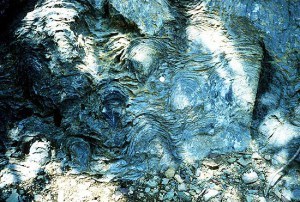
Pre-Cambrian fossil, 3.5 billion years old, but reminds me of a starry sky by Van Gough. Thanks to the US National Park Service
Life arose on Earth
In conditions fairly rare,
Yet as the universe matures
Life could be everywhere.
With star formation winding down,
Supernovae will dwindle,
Small dim stars proliferate,
More room for life to wiggle.
Impatient were our ancestors
Or maybe we’re just lucky
Self-replicating molecules
Simply weren’t too fussy.
Earth may be a pioneer
With most life future-tense,
Good news for astrobiologists
Five billion years hence.
By Kate Rauner
My schedule got away from me this week, so I’m posting my weekly poem late. I hope it’s worth the wait, and my thanks to smithsonianmag.com
Filed under: Poetry Tagged: alien life, origin of life, poetry, science, stars, universe. poem











